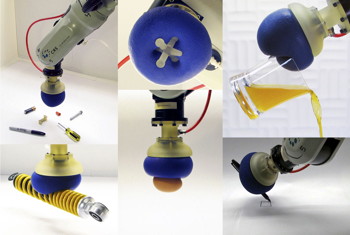ESSENTIALS
The Essentials
CREATED@CORNELLRobotic gripper makes marketplace debut
A Cornell-developed robotic gripper that can pick up, place and throw things with ease is making its first foray into the marketplace.
Cornell spinoff company Empire Robotics has been developing commercial "jamming" grippers for the industrial automation market, and they are now taking orders for the limited first release of their product, called VERSABALL.
John Amend, a former Cornell graduate student who developed the gripper technology while he worked in Hod Lipson's Creative Machines Lab, co-founded Empire Robotics after he graduated in 2013.
How do VERSABALL grippers work? According to a company FAQ: Imagine putting flour inside a party balloon and evacuating the air to make the balloon transition from rock-solid to squishy like a stress ball.
This "jamming transition," as the scientists call it, works with pretty much any granular material. In fact, early prototypes used coffee grounds for the jamming granules.
Cornell ice cream returns to Dairy Bar
Cornell Dairy ice cream returned to campus for retail sale in January, following a three-year absence while the Cornell dairy plant was being rebuilt as part of the $105 million renovation to Stocking Hall, home of the Department of Food Science.
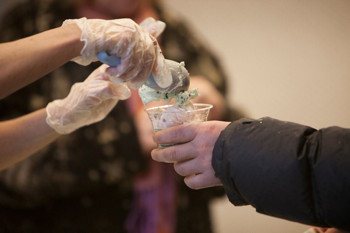
Cornell Dairy ice cream is once again being sold on campus. See larger image
A celebration Jan. 14 at Stocking Hall was marked by presentations by leaders of the Department of Food Science, the College of Agriculture and Life Sciences (CALS) and Cornell Dining – and a surprise visit from President David Skorton, who quipped that he was just there for the ice cream.
CALS Senior Associate Dean Max Pfeffer gave thanks to the nine dairy plant staff members. "This dedicated team can always be relied upon to get the job done, no matter what the challenges, and all while being under the watchful eye of the public behind the glass walls and observation gallery of the new dairy plant," he said.
Pfeffer also thanked Perry's Ice Cream for keeping the Cornell campus supplied with its product during the renovation.
It took several months for dairy plant staff to build up enough supply to meet the expected demand of a campus hungry for favorites such as Bavarian Raspberry Fudge. Nineteen flavors are now being served by the scoop or the pint at the Dairy Bar and an additional nine will be available soon, including several designed by students.
Michael Pesko is changing the world
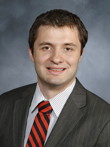
Michael Pesko. See larger image
Forbes magazine named Michael Pesko, assistant professor in the Department of Healthcare Policy and Research at Weill Cornell Medical College, to its list of 30 Under 30 Who Are Changing the World 2014.
Writes Forbes: "Pesko's work focuses on learning more about the behavior of smokers and how and why they keep lighting up. Three studies documented the many ways smokers avoid higher cigarette prices, foiling attempts to cut their nicotine usage. Another paper showed that 1 million former smokers took up the habit again due to 9/11 – and then never stopped."
Pesko's research lies at the intersection of health economics, behavioral health, health care delivery and econometrics. He investigates how people and systems react to incentives in ways that promote and discourage health, and uses secondary data to assess the impact of changes in regulatory policies and technology on health care delivery and substance use.
Student's yak research may reduce infection in Nepal
Simple changes in food handling, preparation and animal husbandry could have a significant impact on the incidence of zoonotic disease (infections that spread from animals to humans), reports Daniel Jackson, a DVM candidate in Cornell's Class of 2014, in the January issue of the journal Preventive Veterinary Medicine.
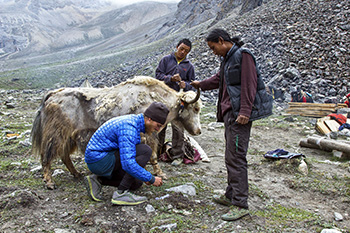
Daniel Jackson '14 spent eight weeks in remote regions of Nepal to study yaks and their herders. Photo: Provided. See larger image
Brucellosis, which is transmitted to people by drinking unpasteurized milk or through close contact with aborted reproductive fluids and tissues, is the most common bacterial zoonotic infection in the world and is endemic to Nepal.
Jackson assessed the burden, prevalence and distribution of brucellosis in domestic yak and their herders in the mountain region of Nepal's Shey Phoksumdo National Park. With funding from the College of Veterinary Medicine's Expanding Horizons program and other sources, Jackson visited Nepal's Yak Breeding Station in Syangboche and toured veterinary facilities and colleges in Kathmandu with Nepalese veterinarians and veterinary students.
Jackson spent eight weeks in remote regions of Nepal that required large animal clinical skills, psychological and physical stamina, and a great measure of patience, Jackson said. He walked for approximately 45 days employing a donkey team and a small research team including a guide and translator."
"In the United States, we are fortunate to have systems in place that reduce the risk of disease transmission," said Jackson. "In rural Nepal, knowledge about basic food safety and disease transmission is lacking. Small, simple changes based on the identification of risk stand to make a large impact."
Smithsonian celebrates Cornell on Mars
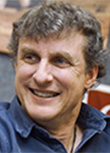
Professor Steve Squyres. See larger image
It's an exploration celebration: The Smithsonian Institution’s National Air and Space Museum in Washington, D.C., has opened a new exhibit, "Spirit & Opportunity: 10 Years Roving Across Mars."
The retrospective recounts the Mars Rovers' tandem missions in colorful images as well as the Cornell scientific triumphs of the rovers Spirit and Opportunity.
The twin Mars Exploration Rovers were launched from Cape Canaveral, Fla., in summer 2003 and each landed on the red planet in January 2004. Steve Squyres '78, Ph.D. '81, Cornell professor of astronomy and principal scientist on the mission, led other Cornell professors, researchers and students on this scientific endeavor, controlling the rovers across the solar system.
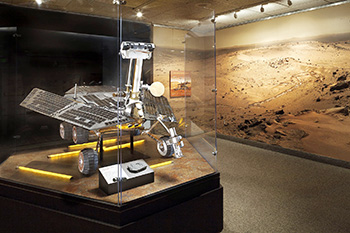
Detail of the exhibit 'Spirit & Opportunity: 10 Years Roving Across Mars' at The Smithsonian Institution in Washington, D.C. Photo: Eric Long, Smithsonian Institution. See larger image
Squyres and other scientists sought Martian rocks and soil that held clues to the presence of water in planet's past. Cornell's contributions include the Panoramic Camera (Pancam), Miniature Thermal Emission Spectrometer (Mini-TES), Mössbauer spectrometer, the Rock Abrasion Tool (RAT), Alpha particle X-ray spectrometer (APXS). Bill Nye '77 helped design the color-calibration sundial.
Cornell University, the Jet Propulsion Laboratory and NASA contributed to the exhibit, which runs through Sept. 14, 2014.
